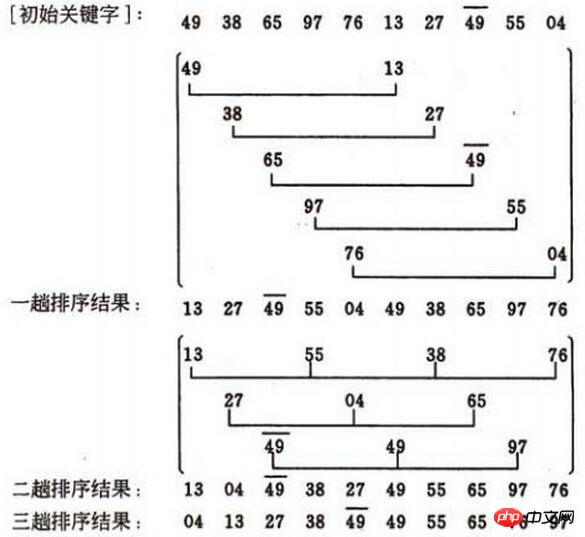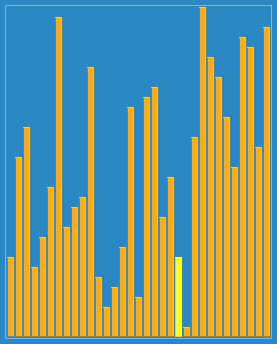Code example of Python implementing Hill sorting
This article mainly introduces the implementation of Hill sorting in Python. The programmed Hill sorting has certain reference value. Interested friends can refer to it
Observe "insertion sort" : In fact, it is not difficult to find that she has a shortcoming:
If the data is "5, 4, 3, 2, 1", at this time we will insert the records in the "unordered block" into the "with" "Sequence block", it is estimated that we will crash, and the position will be moved every time we insert. At this time, the efficiency of insertion sort can be imagined.
Based on this weakness, the shell has improved the algorithm and incorporated an idea called "reducing incremental sorting method". It is actually quite simple, but something to note is:
Increment It's not random, but there are rules to follow.

Timeliness analysis of Hill sorting is difficult. The number of comparisons of key codes and the number of record moves depend on the selection of the increment factor sequence d, in certain circumstances The following can accurately estimate the number of key code comparisons and the number of recorded moves. No one has yet given a method for selecting the best incremental factor sequence. The sequence of incremental factors can be taken in various ways, including odd numbers and prime numbers. However, it should be noted that there are no common factors among the incremental factors except 1, and the last incremental factor must be 1. . Hill sorting method is an unstable sorting method. First of all, we need to clarify the method of increment (the pictures here are copied from other people's blogs, the increment is an odd number, and my programming below uses an even number):
The first increment The method of selecting is: d=count/2;
The method of selecting the second increment is: d=(count/2)/2;
Finally, it goes to: d=1;
Okay, pay attention to the picture. The increment d1=5 in the first pass divides the 10 records to be sorted into 5 subsequences,
performs direct insertion sorting respectively, the result is (13, 27, 49, 55, 04, 49, 38, 65, 97, 76)The increment of the second pass is d2=3, and the 10 to-be-queued records are divided into 3 subsequences, and direct insertion is performed respectively. Sorting, the result is (13, 04, 49, 38, 27, 49, 55, 65, 97, 76)
The increment of the third pass is d3=1, direct insertion sorting is performed on the entire sequence,
The final result is (04, 13, 27, 38, 49, 49, 55, 65, 76, 97)Here comes the key point. When the increment decreases to 1, the sequence is basically in order.
The last pass of Hill sorting is direct insertion sortingwhich is close to the best situation. The "macro" adjustments in the previous passes can be regarded as the preprocessing of the last pass, which is more efficient than doing only one direct insertion sort. I am learning python, and today I used python to implement Hill sorting.
def ShellInsetSort(array, len_array, dk): # 直接插入排序
for i in range(dk, len_array): # 从下标为dk的数进行插入排序
position = i
current_val = array[position] # 要插入的数
index = i
j = int(index / dk) # index与dk的商
index = index - j * dk
# while True: # 找到第一个的下标,在增量为dk中,第一个的下标index必然 0<=index<dk
# index = index - dk
# if 0<=index and index <dk:
# break
# position>index,要插入的数的下标必须得大于第一个下标
while position > index and current_val < array[position-dk]:
array[position] = array[position-dk] # 往后移动
position = position-dk
else:
array[position] = current_val
def ShellSort(array, len_array): # 希尔排序
dk = int(len_array/2) # 增量
while(dk >= 1):
ShellInsetSort(array, len_array, dk)
print(">>:",array)
dk = int(dk/2)
if __name__ == "__main__":
array = [49, 38, 65, 97, 76, 13, 27, 49, 55, 4]
print(">:", array)
ShellSort(array, len(array))Output:
>: [49, 38, 65, 97, 76, 13, 27, 49, 55, 4] >>: [13, 27, 49, 55, 4, 49, 38, 65, 97, 76] >>: [4, 27, 13, 49, 38, 55, 49, 65, 97, 76] >>: [4, 13, 27, 38, 49, 49, 55, 65, 76, 97]
First of all, you must know insertion sorting, otherwise you will definitely not understand it.
 #Insertion sort is to insert and sort the numbers in the three yellow boxes in the picture above. For example: 13, 55, 38, 76
#Insertion sort is to insert and sort the numbers in the three yellow boxes in the picture above. For example: 13, 55, 38, 76
Look directly at 55, 55<13, without moving. Then look at 38, 38<55, then 55 is moved back, and the data becomes [13, 55, 55, 76]. Then compare 13<38, then 38 replaces 55 and becomes [13, 38, 55, 76]. The rest are the same, omitted.
There is a problem here, for example, the second yellow box
[27, 4, 65], 4<27, then 27 moves back, then 4 replaces the first one, and the data becomes [ 4, 27, 65],But how does the computer know that 4 is the first one??My approach is to first
find the first one of [27, 4, 65] The subscript of a number. In this example, the subscript of 27 is 1. When the subscript of the number to be inserted is greater than the first subscript 1, it can be moved backward. The previous number cannot be moved backward. There are two situations, one is If there is data in front and it is smaller than the number to be inserted, you can only insert it after it. Another, very important, when the number to be inserted is smaller than all the previous numbers, the inserted number must be placed first. At this time, the subscript of the number to be inserted = the subscript of the first number. (This passage may not be very understandable to beginners...)In order to find the subscript of the first number, the first thing I thought of was to use a loop, all the way to the front:
while True: # 找到第一个的下标,在增量为dk中,第一个的下标index必然 0<=index<dk index = index - dk if 0<=index and index <dk: break
When debugging, I found that using loops is a waste of time, especially when the increment d=1. In order to insert the last number in the list directly, I have to loop by 1 until the subscript of the first number. Later I learned Be smart, use the following method:
j = int(index / dk) # index与dk的商 index = index - j * dk
Time complexity:
The time complexity of Hill sorting is a function of the increment sequence taken, and it is difficult to analyze accurately. Some literature points out that when the incremental sequence is d[k]=2^(t-k+1), the time complexity of Hill sorting is
O(n^1.5),where t is sorting Number of trips. Stability: Unstable
Hill sorting effect:

Reference materials: The programming is implemented by myself. It is recommended to Debug and take a look at the running process
Eight sorting algorithms in c++
Visually and intuitively experience several commonly used sorting algorithms
C#Seven classic sorting algorithm series (Part 2)
1. Non-systematic learning is also a waste of time. 2. Be a technical person who can appreciate beauty, understand art, and be good at art
The above is the detailed content of Code example of Python implementing Hill sorting. For more information, please follow other related articles on the PHP Chinese website!

Hot AI Tools

Undresser.AI Undress
AI-powered app for creating realistic nude photos

AI Clothes Remover
Online AI tool for removing clothes from photos.

Undress AI Tool
Undress images for free

Clothoff.io
AI clothes remover

Video Face Swap
Swap faces in any video effortlessly with our completely free AI face swap tool!

Hot Article

Hot Tools

Notepad++7.3.1
Easy-to-use and free code editor

SublimeText3 Chinese version
Chinese version, very easy to use

Zend Studio 13.0.1
Powerful PHP integrated development environment

Dreamweaver CS6
Visual web development tools

SublimeText3 Mac version
God-level code editing software (SublimeText3)

Hot Topics
 1662
1662
 14
14
 1418
1418
 52
52
 1311
1311
 25
25
 1261
1261
 29
29
 1234
1234
 24
24
 PHP and Python: Different Paradigms Explained
Apr 18, 2025 am 12:26 AM
PHP and Python: Different Paradigms Explained
Apr 18, 2025 am 12:26 AM
PHP is mainly procedural programming, but also supports object-oriented programming (OOP); Python supports a variety of paradigms, including OOP, functional and procedural programming. PHP is suitable for web development, and Python is suitable for a variety of applications such as data analysis and machine learning.
 Choosing Between PHP and Python: A Guide
Apr 18, 2025 am 12:24 AM
Choosing Between PHP and Python: A Guide
Apr 18, 2025 am 12:24 AM
PHP is suitable for web development and rapid prototyping, and Python is suitable for data science and machine learning. 1.PHP is used for dynamic web development, with simple syntax and suitable for rapid development. 2. Python has concise syntax, is suitable for multiple fields, and has a strong library ecosystem.
 PHP and Python: A Deep Dive into Their History
Apr 18, 2025 am 12:25 AM
PHP and Python: A Deep Dive into Their History
Apr 18, 2025 am 12:25 AM
PHP originated in 1994 and was developed by RasmusLerdorf. It was originally used to track website visitors and gradually evolved into a server-side scripting language and was widely used in web development. Python was developed by Guidovan Rossum in the late 1980s and was first released in 1991. It emphasizes code readability and simplicity, and is suitable for scientific computing, data analysis and other fields.
 Python vs. JavaScript: The Learning Curve and Ease of Use
Apr 16, 2025 am 12:12 AM
Python vs. JavaScript: The Learning Curve and Ease of Use
Apr 16, 2025 am 12:12 AM
Python is more suitable for beginners, with a smooth learning curve and concise syntax; JavaScript is suitable for front-end development, with a steep learning curve and flexible syntax. 1. Python syntax is intuitive and suitable for data science and back-end development. 2. JavaScript is flexible and widely used in front-end and server-side programming.
 How to run sublime code python
Apr 16, 2025 am 08:48 AM
How to run sublime code python
Apr 16, 2025 am 08:48 AM
To run Python code in Sublime Text, you need to install the Python plug-in first, then create a .py file and write the code, and finally press Ctrl B to run the code, and the output will be displayed in the console.
 Where to write code in vscode
Apr 15, 2025 pm 09:54 PM
Where to write code in vscode
Apr 15, 2025 pm 09:54 PM
Writing code in Visual Studio Code (VSCode) is simple and easy to use. Just install VSCode, create a project, select a language, create a file, write code, save and run it. The advantages of VSCode include cross-platform, free and open source, powerful features, rich extensions, and lightweight and fast.
 Can visual studio code be used in python
Apr 15, 2025 pm 08:18 PM
Can visual studio code be used in python
Apr 15, 2025 pm 08:18 PM
VS Code can be used to write Python and provides many features that make it an ideal tool for developing Python applications. It allows users to: install Python extensions to get functions such as code completion, syntax highlighting, and debugging. Use the debugger to track code step by step, find and fix errors. Integrate Git for version control. Use code formatting tools to maintain code consistency. Use the Linting tool to spot potential problems ahead of time.
 How to run python with notepad
Apr 16, 2025 pm 07:33 PM
How to run python with notepad
Apr 16, 2025 pm 07:33 PM
Running Python code in Notepad requires the Python executable and NppExec plug-in to be installed. After installing Python and adding PATH to it, configure the command "python" and the parameter "{CURRENT_DIRECTORY}{FILE_NAME}" in the NppExec plug-in to run Python code in Notepad through the shortcut key "F6".




